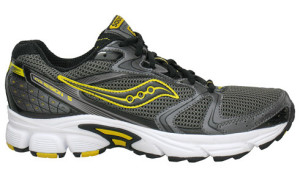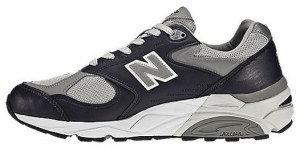You take approximately 1,000 steps with each foot with every mile you run, so you want every one of those steps to be as comfortable as possible. With all the different types of running shoes on the market and all their bells and whistles, how do you know what you need? The choice is actually quite simple.
Two of the most common questions I’m asked are, “What’s the best running shoe?” and “What shoes should I get?” Well, there’s no best running shoe. The best pair of shoes for you comes down to what feels comfortable, the amount of support you need, how much you run, and how much your foot pronates.
If you’re like most runners, when your foot lands, the outside part of your heel contacts the ground first. Your foot then rolls inward until it’s in contact with the ground to optimally distribute the forces of impact. With your whole foot on the ground through the stance phase, you use the entire ball of your foot to push off.
If you’re an overpronator, your foot rolls inward more than is ideal because your foot and ankle can’t adequately stabilize your leg. Because your ankle collapses inward, more of your weight is on the inside part of your foot, and you push off the ground using your big toe and second toe rather than distributing the force evenly across the ball of your foot. Overpronation is a major cause of running-related injuries.
If you’re an underpronator, your foot doesn’t roll inward enough after the outside of the heel lands. Consequently, the outside of your foot takes the brunt of the impact. Because your foot remains on its outside edge, you push off the ground using the smaller toes on the outside of your foot rather than distributing the force evenly across the ball of your foot.
When you walk into a running shoe store, the array of shoes can be dizzying. Despite the large selection, there really aren’t as many shoes as it seems. Fewer types of shoes exist than do types of toothpaste. (You should have more trouble choosing toothpaste.) And depending on the way you run and the surface you run on, you can discount at least two-thirds of the options right away.
Running shoes have specific combinations of support and stability designed for different running gaits. Shoes are divided into three major categories — cushioning/neutral, stability, and motion control. Other shoes are designed for specific running conditions, such as trail running and racing. When you know which category you need, you can start looking for the shoes that feel comfortable right out of the box.
Cushioning/Neutral Shoes
Cushioning shoes (sometimes called neutral shoes) allow you to pronate naturally to absorb shock upon landing. They’re best suited for runners with normal to high arches. They have minimal medial (arch-side) support, which you can see by the shoes’ curved last — the mold around which a shoe is constructed. Cushioning shoes are distinguishable by the rubber on the medial side; it’s compressible and is usually white. If you have a normal arch, don’t overpronate, or underpronate (not common, but it happens), get cushioning/neutral shoes.
Stability Shoes
Stability shoes allow only limited pronation while retaining some cushioning characteristics. They’re best suited for runners who have normal to low arches and mild to moderate pronation. You can tell a stability shoe by its added material on the medial side, which is firmer to the touch. If you have a normal or low arch and overpronate slightly, get stability shoes.
Motion-Control Shoes
Motion-control shoes do exactly what their name implies — they control your foot’s motion. They’re best suited for runners with flat feet and severe overpronation. They have a straighter last than cushioning and stability shoes and contain a harder material on the medial side that’s usually of a darker color than the rest of the rubber cushioning. If you have a very low arch (flat feet) and your foot rolls inward so much that it looks like it’s about to fall sideways off a cliff, get motion-control shoes.
Trail Shoes
Trail shoes are specifically designed for running on trails. They have more support than road-running shoes and greater traction on the sole, and they’re a darker color given how dirty they get when you run on trails. Almost all trail shoes fall in the stability shoe category.
Racing Flats
Racing flats are very lightweight cushioning shoes made for racing on the road. Although the best runners wear racing flats even for races as long as a marathon, I wouldn’t recommend wearing them for a race that long unless you’re light on your feet, you have an efficient running style with normal pronation, and you’ve trained substantially in them.
Too many runners (and running shoe manufacturers) are quick to blame their shoes when they get injured. As long as you have the right shoe for your foot and running mechanics (which is a an easy fix), your shoes are not the reason you get injured. The main reason why runners get injured is because of faulty training and increasing the stress of running by too much too quickly for your body to adapt. If you want to avoid injuries, don’t blame your shoes. Just train smarter.
Want to find out the secrets of how never to get injured? Download a copy of my new e-book, Secrets of Running Injury Prevention.






2 Responses to Picking the Right Running Shoe